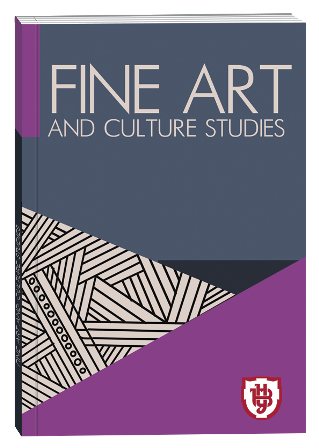RESEARCH ON OF THE ROLE AND FUNCTIONS OF THE TORSO IN THE PROCESS OF VOCALIZATION
DOI:
https://doi.org/10.32782/facs-2022-2-8Keywords:
respiratory physiology, complete respiratory cycle, anchoring, vocal support, torso.Abstract
The article deals with one of the important problems of studying the role and function of the torso in the process of vocalization and related singing breathing and the formation of correct posture during singing. This will make it possible to scientifically substantiate the physiological patterns of the human body and make the process of singing activity as a whole more understandable and transparent. The issue is revealed in the relationship of such components as: the work of the autonomic nervous system, which signals motor tasks to muscle fibers in the human body, and the general functioning of the respiratory system, which performs a full respiratory cycle. In this context, the process of breathing during vocalization is analyzed in detail and the role of each torso organ is determined separately. It is noted that physiological singing breathing is regulated by motor tasks of various types, including: slow set, fast set, medium set in the muscle fibers of the diaphragm during exhalation, and so on. Attention is focused on the fact that physiological breathing includes the entire plane of the lower torso, so that the lower ribs, diaphragm, back muscles, and chest participate in the vocalization process, which can work simultaneously. At the same time, the amplitude of a person’s respiratory movements will depend on the physiological and psychological and emotional state of the person. The methodology of this study is to change its angle, which will allow us to identify the essential components of the torso and analyze their role in the process of vocalization. Scientific novelty consists in identifying the mechanisms of interaction between various components of the human torso and their influence on the process of sound extraction. The practical significance of the study lies in the focus on safe approaches in the formation of singing breathing skills during the vocalization process. The results of the study can be used for further research and development of vocal techniques.
References
Валік Б. (2006) Підготовка м’язів, що забезпечують правильну поставу та пружні властивості стопи // Фізична культура у школі. № 8. С. 59–62.
Соловйова І. (2006) На славу скакалки // Фізична культура у шкільництві.. № 7. С. 38–40.
Соколенко В., Весніна Л., Жукова М., Міщенко І., Ткаченко Л. (2019) Фізіологія системи дихання. Модуль 2. Фізіологія вісцеральних систем : навч.-метод. посіб. для студентів медичних вузів України. Полтава. 160 с.
Corda M., Von Euler C. and Lennerstr G. (1965) Proprioceptive innervation of the diaphragm. J. Physiol. 178. Р. 161–177.
Nguyen A., Amirjani N., McCaughey X. E. J., Gandevia X. S. C., Butler X. J. E. and Hudson X. A. L. (2015) Differential activation of the human costal and crural diaphragm during voluntary and involuntary breaths X D.
Estill J., Kobayashi N., Honda K., Kakita Y. (1990) A Study on Respiratory and Glottal Controls in Six Western Singing Qualities: Air flow and Intensity Measurement of Professional Singing. in ICSL. P. 169–172.
Hoit J., Hixon T. (1986) Body type and speech breathing. J. Speech Hear. Res. 29. Р. 313–324.
Howorth M. (1956) Posture in adolescents and adults. The American journal of nursing. Jan 1: 34 – 6.
Yeo S., Lee R., McCabe P., Madill C. (2018) Effects of Different Lung Volume Conditions on Closed Quotient // Vocal Fundamental Frequency and Relative Intensity in Vocally Untrained Female Speakers. Acoust. Aust. 46. Р. 339–347.
Gardiner M. (1957) The principles of exercise therapy. Bell.
Lattitia Peultier-Celli, Mathilde Audouin, Christian Beyaert, and Philippe Perrin (2020) “Postural Control in Lyric Singers”.
Levangie P., Norkin C. (2011) Joint Structure and Function: A Comprehensive Analysis by F. A. DAVIS Company P. USA.
Linklater Kristin (2006) “Freeing the Natural Voice: Imagery and Art in the Practice of Voice and Language”. 381 р.
Matthew J., Fogarty Carlos B., Mantilla and Gary C. (2018) Sieck // Breathing: Motor Control of Diaphragm Muscle // PHYSIOLOGY 33: Published February 7. Р. 113–126.
Pettersen V. & Westgaard R. (2004). Muscle activity in professional classical singing: a study on muscles in the shoulder, neck and trunk. Logopedics Phonatrics Vocology, 29 (2): 56–65.
Pettersen V. (2005). Muscular patterns and activation levels of auxiliary breathing muscles and thorax movement in classical singing. Folia Phoniatricaet Logopaedica, 57 (5–6): 255–277.
Pettersen V., Bjorkoy K., Torp H. & Westgaard R. H. (2005). Neck and shoulder muscle activity and thorax movement in singing and speaking tasks with variation in vocal loudness and pitch. Journal of Voice, 19 (4). P. 623–634.
Steinhauer Kimberly, Mary McDonald Klimek, Jo Estill (2017) “The Estill Voice Model Theory and Translation”. 281 р.
Shahideh S., Christoph A., Andrew C., James W, Harkina Andrew P., Prayled Milind P., Sovanie Charlotte E., Boltonbf Penny A., Gowland P. Hallab (2020) Assessing the impact of posture on diaphragm morphology and function using an open upright MRI system. A pilot study.
Traser L. (2020) Respiratory kinematics and the regulation of subglottic pressure for phonation of pitch jumps – a dynamic MRI study. 21. Watson P., Hixon T. (1985) Respiratory kinematics in classical (opera) singers. J. Speech Hear. Res. 28, 104–122.







